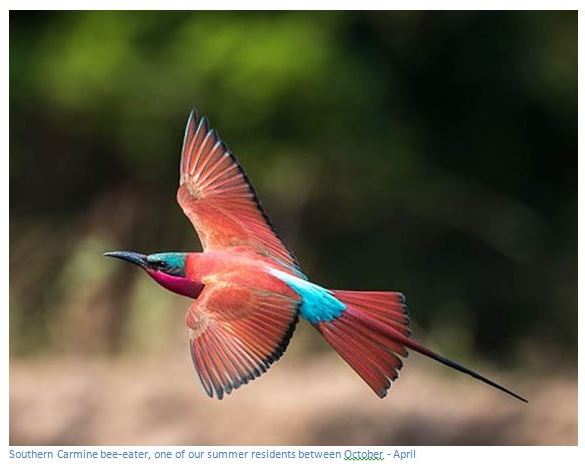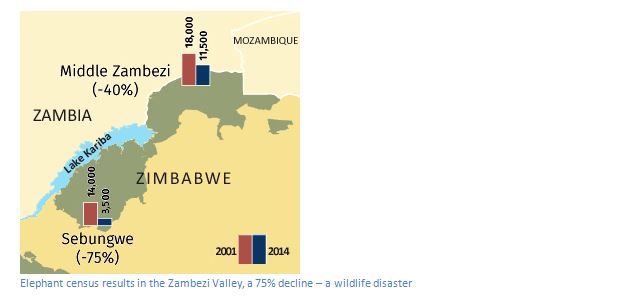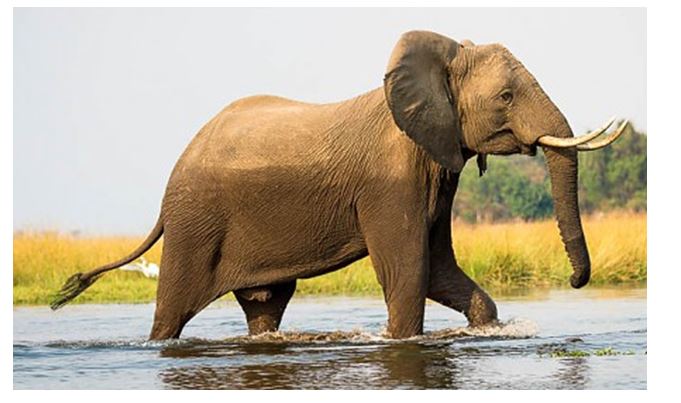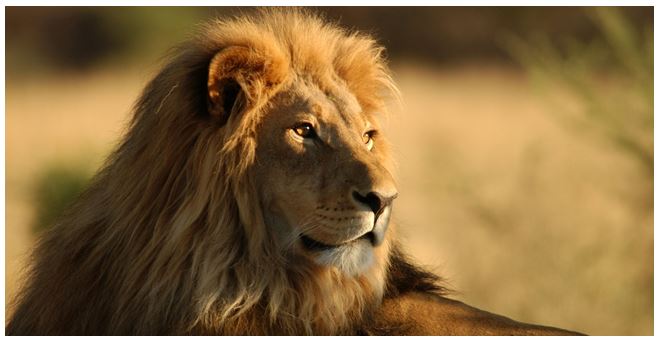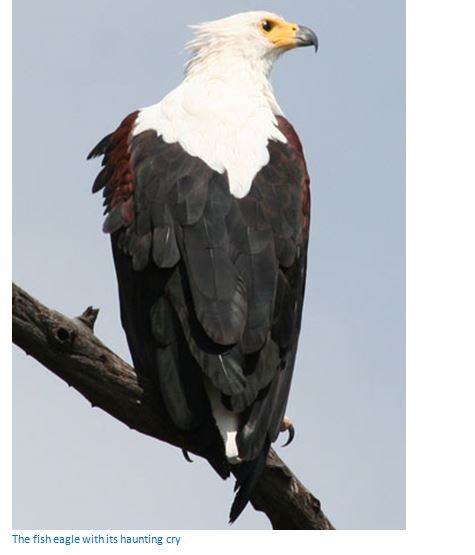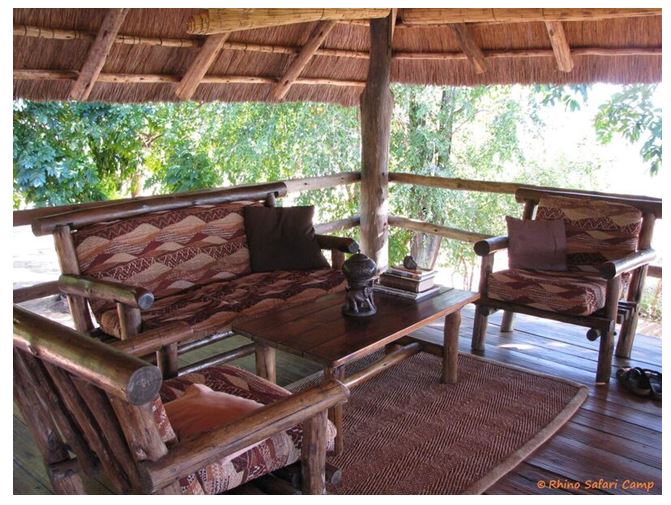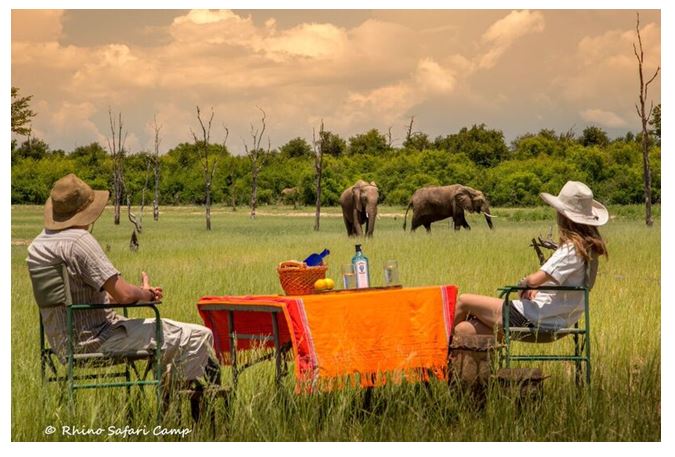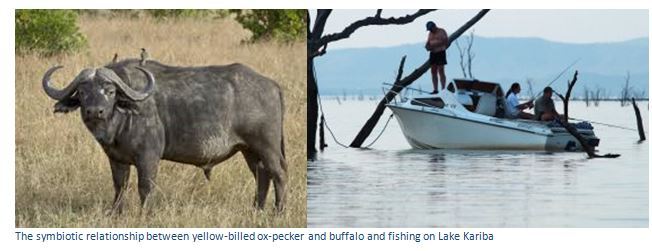Matusadonha National Park
- Game viewing in extreme wilderness areas
- Hiking and escarpment climbing
- Game viewing along the lake shoreline from the safety of houseboats
- Fishing in the rivers and inlets of Lake Kariba
- Bird watching in the breath taking Sanyati Gorge
- Boating and canoeing safaris on the Lake and along the shoreline
During the rainy season flooding rivers are a problem and the wildlife can spread throughout the Matusadonha National Park as there is widespread water, so do not consider visiting from December to March. Game viewing takes place in the dry season between April to August when there is no rain and from September to October when the area is very hot and animals are concentrated on the lakeshore.
Animal Species
Elephant, buffalo, lion, kudu, impala, hippo, Nile crocodile, black rhinoceros, spotted hyena, leopard, civet, zebra, warthog, side-striped jackal, roan antelope and over 40 fish species
Matusadonha is on the south eastern shore of Lake Kariba between the Ume River on the west and the Sanyati River, well-known for its spectacular gorge.
By road take the A1 Harare to Chirundu national road, 115 KM reach Chinhoyi, 207 KM reach Karoi (the last town where supplies and fuel can be bought) as normally the Park is reached via Karoi, but it can also be accessed from Victoria Falls, via Binga. Distances are from Karoi, 8 KM north of Karoi on the Harare-Chirundu Road turn left through the Hurungwe communal land for Magunue which is 24 KM away, 115 KM from Karoi cross the Sanyati River and continue on the Binga Road, 177 KM turn right and 259 KM reach Tashinga, the headquarters of the Park. Except for a short distance of narrow tar, when one leaves the Harare-Chirundu Road, the roads are either gravel or dirt. The roads are rough and not suitable for saloon and low clearance vehicles. Enquire from ZimParks about the condition of the road before starting your journey. Game viewing roads are closed during the rainy season.Be warned that locals advise that access by road is only for the seriously adventurous which requires a proper 4x4 with decent ground clearance and preferably with a diff-lock. From Harare or Binga to Rhino it is roughly 12-14 hours depending on the time of year and state of the roads.
By air, a small, 800 metre landing strip is licensed Category II at Tashinga Camp and can take small light aircraft such as the Cessna 206 or smaller. From Tashinga to Rhino Safari Camp is a transfer by vehicle (30-45 minutes) or by speed boat (5-10 minutes). Rokari/Kiplings which is at the Ume Croc Farm and is where most visitors fly into because the strip is close enough to the harbour to walk and local Safari camps, such as Rhino Safari Camp will meet and porter the luggage and transfer by speed boat and takes roughly half an hour to Rhino safari Camp. Bumi airstrip requires a ground transfer between the airstrip and the harbour and Bumi isn’t always able to do this, especially if they are busy with their own guests.
By boat, visitors can come in from Bumi Hills located 14 Kilometres from Tashinga, or 50 Kilometres across the Lake from Kariba town and takes just over an hour, depending on lake conditions.
See the update in a recent article on the 20 year agreement between African Parks and Zimparks which will hopefully transform wildlife prospects in the Mavuradonha National Park.
Matusadonha National Park has as its southern boundary the Omay Communal land and the northern boundary is the Lake Kariba shore, the eastern side is the Sanyati Gorge and the Ume River forms the western boundary. Visitors concentrate on visiting the area in the north of the National Park between the Matusadonha hills, which form part of the Zambezi Escarpment, and the lakeshore which is particularly attractive and has a network of gravel roads. South of the Matusadonha hills is mountainous area and remote, with access restricted to tracks from the Binga-Karoi road and the main access road. There are no campsites in this area and a permit is required before entry.
Before the lake was built, Matusadonha was a vast, rugged wilderness with limited access and had been proclaimed a non-hunting area in 1958. It became a Game Reserve in 1963, and in 1975 a National Park comprising some 1,400 square kilometres (540 square miles) of diverse flora and fauna.
Matusadona is an Intensive Protection Zone (IPZ) and home to relocated rhinoceros.
Flora and Fauna
Matusadonha has three distinct ecological areas:
Lake and shoreline grassland from Lake Kariba, probably the most far-reaching of the ecological changes, particularly the introduction of Panicum repens, a rejuvenative grass found on the shoreline which only needs the fluctuating lake levels to replenish its nutrients. With this new food source, elephant, buffalo, waterbuck, zebra, and even impala populations have increased greatly and following close behind them have come the predators
Zambezi Valley floor with a mass of thick Jesse and mopane woodland which is sparsely grassed, but provides habitat for browsers, most notably the black rhino. Elephants range throughout the Park, but seek the shade of the Jesse in the heat of the day.
Zambezi Escarpment area of Julbernardia and Brachystegia woodlands. The Escarpment rises some 700 metres above the Valley floor and is extremely rugged. Over the years, elephant and fire depredations have caused the once substantial woodlands to dwindle, and in parts, grasslands have taken over. It has become necessary to carry out early burning programmes in the upper escarpment, to prevent later, hot fires causing serious damage to tree growth.
Some of the more elusive animal species found include the clawless otter, white-tailed mongoose, reedbuck, sable antelope, eland, civet, rusty spotted genet, caracal and bush pig.
Conservation issues
- Loss of black rhino and elephant are a hot topic as so many have been poached in the remote areas of this National Park,
- The environmental impacts of rising water levels at Lake Kariba. In 2013 the water levels went up because remedial work had been done on the plunge pool at the base of the dam wall and this delayed the opening of the floodgates. The high lake levels reduces the area of lakeside grazing available to species such as buffalo and zebra, and these populations tend to decline if these conditions persist for more than a year or two.
- Implications of proposed tsetse fly clearance for wildlife and wilderness.
- In 1994 a new cheetah population was introduced and has survived and grown since; today cheetah sightings are quite common again.
In a recent newsletter (August 2015) The Zambezi Society highlighted statistics derived from a national air survey as part of the Africa-wide Great Elephant Census, which surveyed all major elephant populations in Africa in 2014. There has been a 75% decline in the numbers of elephants in the Zambezi Valley south of Lake Kariba since 2001, a decline in numbers from 14,000 to 3,500: a wildlife crisis of huge proportions. This coincides with a huge escalation in the demand and price of elephant tusks in China since 2002. China’s legal ivory trade, it believes, is acting as a smokescreen for horrific escalation of illegal activities which are driving the unsustainable killing of Africa’s elephants.
A recent census in Tanzania revealed a catastrophic 60% loss of that country’s elephants in just five years (109,051 in 2009 to 43,330 in 2014). Mozambique has lost around 50% in the same period from 20,000 to 10,300. In Africa (and Zimbabwe is no exception), state wildlife authorities are unable to provide sufficient policing and protection of wildlife areas. The costs of protection are high, but government funds allocated for the purpose are negligible. This gap is exploited by corruption and rangers on the ground are highly experienced, but poorly paid.
Organisations such as The Zambezi Society say the message for Zimbabwe’s Zambezi Valley is clear – “poaching is rife and we need to do something about it urgently.” The Society has a Memorandum of Understanding with ZWPMA and a 30-year-old history of working with the Authority, other NGOs and the private sector to assist in combating anti-poaching in the Zambezi Valley.
However, in the past year, the Zambezi Society reports that situation has started to improve because of the collaborative efforts between ZPWMA, law enforcement agencies and NGO’s. The Zambezi Society continues to provide assistance to anti-poaching efforts in the Matusadonha National Park conducted by the following:-
MAPP (The Matusadona Anti-Poaching Project): The Zambezi Society provides vehicle and fuel support to the increasingly successful anti-poaching efforts of MAPP which was established several years ago to help protect the fish and wildlife resources of the Matusadona National Park on the southern shores of Lake Kariba. In 2015, after introducing a very successful "informer" operation and working with the authorities to tighten-up on law-enforcement procedures, MAPP reported the following operational successes for the year: a total of 160 years of jail sentences for poaching and other illegal activities in the National Park; 3 poacher fatalities; more than 30 illegal weapons seized from villages surrounding the Park. MAPP's successes have continued to gain momentum into 2016.
BHAPU (Bumi Hills Anti-Poaching Unit): Bumi Hills Safari Lodge & Spa runs its own anti-poaching unit, helping to protect fishing and wildlife in its own concession and in the settled lands to the west of the Matusadona National Park. It collaborates with MAPP within the Park itself.
The Matusadona Anti-poaching Project (MAPP) (www.facebook.com/Matusadona-Anti-Poaching-Project) was launched in early 2013 by Zimbabwe Parks and Wildlife Management Authority (ZPWMA) The Tashinga Initiative (TTI) and the resorts of Changa Safari Camp and Spurwing Island Resort. In order to be successful in their anti-poaching operations the ZPWMA rangers need to be adequately equipped and collaboration with organisations such as Conservation Zambezi (www.conservationzambezi.org) and the Zambezi Society (www.zamsoc.org) has resulted in donations of radio communications, speedboats and engines, vehicles, solar power and education materials. A 24-hour hotline with rewards for information has been very successful.
The Zambezi Elephant Fund (ZEF) (www.zambezielephantfund.org) has been formed specifically to address the escalating rise of poaching in the Zambezi Valley in Zimbabwe. It organisation began when John Stevens, a private guide who operates in the area, decided to do something about this. Like-minded concerned individuals, operators, NGOs and relevant government bodies joined him and formed the collaborative ZEF initiative.
Most of the Zambezi Valley has already lost its rhino population to poaching and is now losing elephants every month for their ivory. ZEF works collaboratively with the Zimbabwean government, NGOs and the private sector to develop, implement and manage:
-Anti-poaching operations
-Field equipment and supplies for rangers and support teams
-Anti-poaching ranger training
-Conservation security planning and implementation
-Information systems and networking
-Technology and systems for anti-poaching operations
They aim to protect elephants in the Zambezi Valley, Zimbabwe by putting a stop to poaching and developing and putting in place systems that ensure the long-term safety of these incredible animals and the security and growth of other wildlife in the area, together with the protection of the environment and the improvement and sustainability of these efforts.
ZEF recognises the importance of involving and supporting local communities in a wide range of areas within the Zambezi valley including Binga, Chewore, Chirundu, Chizarira, Kanyemba, Kariba Town, Lake Kariba, Mana Pools, Matusadona, Mavuradonha, Mlibizi and Msuna, Mongwe, Sapi and Victoria Falls.
Fishing
For many years the Matusadonha has been plagued by Zambian and local fish poachers entering the Sanyati Gorge at night indiscriminately netting the fish populations. Semi-permanent camps had been established and up to five Zambian fishing boats would enter these waters nightly to catch all sizes and any species of fish to sell on the lucrative Zambian market. Their activities threatened the very existence of the once healthy fish population in these parts which are a favoured spawning ground of the tiger fish.
In their operations MAPP have taken out almost one hundred and twenty kilometres of netting that has been illegally set by these poachers, in addition, over one hundred and sixty boats have been impounded or destroyed and many fish poachers arrested; jail terms, fines and warnings have been imposed.
Ivory and rhino horn poaching
In 1997 it was estimated there were just thirty black rhinos left in the Matusadonha National Park. Local and international organisations, schools and volunteers have provided vehicles and camera traps to enable the DPWMS to carry out land based ranger patrols to halt the activities of poachers. Local commercial firms have been donating fuel and their mechanics to sustain these anti-poaching operations which has resulted in arrests of a number of persons in possession of ivory and the confiscation of illegal firearms and happily, no new elephant carcasses have been discovered in the National Park recently.
Matusadonha National Park (MNP) once supported Africa’s second highest density of lions. The plentiful grasslands on the foreshore of Lake Kariba provided for large herds of buffalo and consequently the lions thrived. However, following fluctuations in lake levels and increases in poaching, the buffalo herds disappeared, quickly followed by the lions. The last census of lions in 2005 suggested just 28 individuals, down from nearly 90 individuals in 1998, remained. The ALERT Lion project is deeply committed to lion conservation by monitoring lion populations and a better understanding of their behaviour. They are working with Zimbabwe Parks and Wildlife Management Authority (ZPWMA) as part of a conservation strategy and action plan for the diminishing lion population in Zimbabwe.
Camp Facilities - Visitors by boat should note the nearest source of supplies and provisions are found in Kariba town and they need to ensure they are self-sufficient in everything before leaving on a trip. Petrol, diesel and oil are sometimes available at Bumi Harbour, but supplies cannot be guaranteed. Visitors by road should stock up at Karoi.
Tashinga Camp
There are two basic 9-bed brick under thatch rondavel-style “lodges” at Tashinga, the headquarters of the Matusadonha National Park. The lodges overlook the Ume River estuary and consist of two sleeping rondavels housing a bathroom and two bedrooms on either side of a central kitchen/living rondavel with a spacious verandah. There is a beautiful, shady and spacious lakeside campsite at Tashinga on the lake shore with an ablution block with hot and cold water, showers, toilets, wash basins and baths. Firewood and braai facilities are available and some of the camping sites have sleeping shelters.
The lodges are unfenced and wildlife can approach at any time. Access is possible by 4x4 through the Matusadona National Park, but the roads are bad and should only be attempted by very intrepid adventurers and plan for a minimum two-night stay to make the long and challenging journey in and out worthwhile. Speedboat charters to Tashinga are available from Kariba town.
Sanyati Camp
A smaller camping site at Sanyati consists of six sites, each with a braai stand. There is an ablution block with hot and cold water and laundry trough.
Changachirere Camp
Changachirere has an exclusive camping site that caters for one party of a maximum of 10 persons; there is a mini-ablution block and shelter.
Undeveloped Bush Camps at Jenje and Kanjedza
These undeveloped bush camping sites can accommodate a maximum of 10 persons per camp but visitors must be fully-equipped with 4WD.
Ume Exclusive Campsite
This is situated close to Tashinga airstrip on the east bank of the Bumi River, 55 Kilometres from Kariba by boat.
Mbalabala Exclusive Campsites
Also on the Bumi River, 300 metres upstream of Ume Camp.
Muuyu Exclusive Campsite
This is situated at Elephant Point, 44 Kilometres from Kariba by boat, but I am informed this is now leased by Rhino Safari Camp and is no longer available to the general public.
Tour Operator All-inclusive Tours
There are a number of registered tour operators who will take care of all requirements including transport, food, accommodation, activities, safety and transfers and some of these are listed.
Rhino Safari Camp (www.rhinosafaricamp.com) is a luxury, rustic owner-operated classic bush camp set on the shores of Lake Kariba on the western boundary of the Matusadonha National Park where the Ume River joins the Lake. The camp is unfenced with wildlife free to roam and can host upto fourteen guests in seven twin-bedded rooms; all are raised above the ground on wooden stilts and are open-to-the air at the sides and come with private open-air showers and bathrooms. A central thatched double-decked “boma” provides a spacious living/dining/bar area with a splash pool. The safari camp is open all year and promises a genuine safari experience. The Matusadonha National Park a designated IPZ (Intensive Protection Zone) for the highly endangered black rhinoceros. The other Big 5 animals: Lion, buffalo, leopard and elephant are also frequently sighted. There are over 350 documented bird species, resident and migratory, the Lake contains a healthy population of hippos and crocodiles. Lake fishing includes the legendary Tiger Fish, numerous Bream species, Cornish Jack, Vundu, Bottlenose and Catfish.
Visitors can track game on foot, or by vehicle with the armed professional guide, Steve Chinoyi, or relax on a boat with a fishing rod and watch the game come to drink from the Lake. Access is by air charter to Kiplings (Rokari) / Bumi Hills / Tashinga or by speedboat transfer from Kariba town.
Rhino Safari Camp works closely the Zambezi Society (www.zamsoc.org) who co-sponsor the rhino monitors based at Tashinga and assist and promote The Tashinga Initiative (www.thetashingainitiative.org) They also work with MAPP / Matusadona Anti-Poaching Project (https://www.facebook.com/Matusadona-Anti-Poaching-Project-MAPP) in their efforts to assist ZPMWA curb illegal poaching with the Matusadonha National Park.
GPS reference for the main boma: 16⁰46′35.90″S 28⁰28′57.00″E
Website : www.rhinosafaricamp.com
Bumi Hills Safari Lodge and Spa (www.bumihills.com) has been open since 1975 and is perched on the edge of the hilltop with wide-ranging views over Lake Kariba and the shoreline. With its twenty rooms lake facing rooms, infinity pool and health spa, it is less intimate than the safari lodges and has more of the feel of an international hotel and it does offer corporate conferences for up to sixty delegates and a VIP boardroom that seats ten, fully equipped with Wi-Fi. Nevertheless many visitors have limited time and want a package that provides an easy air link with Victoria Falls followed by some game viewing, a sunset cruise and fishing on Lake Kariba and Bumi Hills ticks the boxes. They also run an Anti-Poaching Unit (BHAPU)
Musango Island Safari Camp (www.musangosafaricamp.com) this sixteen bed camp offers an abundance of wildlife and birdlife and Steve Edwards has an intimate knowledge of the history and wildlife of the Matusadona National Park, having run the camp for many years. The main lodge is double story with extensive views over the lake shore and is ideal for watching the glorious sunsets. Meals are communal, children are welcome and are perfectly safe to explore the surroundings; there are nine exclusive rooms under canvas. Musango is well known for unforgettable photographic opportunities and wildlife experiences.
See also the separate article under Chewore Fossil forest site about the large dinosaur Vulcanodon Karibaensis found in 1969 and over 180 million years old, near here on an island in Lake Kariba and is believed to have been an important connecting fossil between primitive Prosauropod dinosaurs of the Triassic period and later sauropod dinosaurs (Brontosaurus) of the Jurassic period. The receding waters of Lake Kariba are revealing more and more potential sites which Steve Edwards has been locating.
Visitors can fly to Bumi Hills airstrip from most locations, or take a one and a half hour speedboat trip from Kariba, or drive directly for a real challenge.
Spurwing Island Lodge (www.spurwingisland.com) is situated on an island offshore from the Matusadonha Mountains which appeals to those who like fishing, or game viewing, or just relaxing. It has stone under thatch chalets and cabins with verandas and tents with stone floors and thatch roofs with zip entrances for up to forty guests. The thatched dining room is open to the breeze with a view of the surrounding lake. A large swimming pool and a bar area look out towards the Matusadonha Mountains. Game viewing is from the water by boat or pontoon, or by safari vehicle, or on foot led by a professional guide. There are dramatic scenic trips up the Sanyati gorge by boat, or fishing trips after Tiger fish, a fierce fighting game fish. For the past few years Spurwing has hosted the annual Zimbabwe Air Rally and in 2015 no less than 36 light aircraft of all different shapes, sizes and colours landed safely on nearby Fothergill airstrip with the crews staying overnight at Fothergill.
Changa Safari Camp (www.changasafaricamp.com) is on a private concession with four and a half kilometres of shoreline on Lake Kariba within the Matusadona National Park and recently named in Africa Geographic’s list of romantic safari destinations in Southern Africa. There are six luxury en-suite tents which are mosquito protected and have fans with private verandas and outdoor bath and shower, plus two family tents with the same facilities sleeping up to 20 guests. Activities include game drives and game walks with trained staff, or fishing and bird-watching; over 350 species have been identified. As well as elephant, buffalo and most of the antelope species, many of their predators may be spotted, or one of the few remaining black rhinos in the area. Or take one of their catamarans with an experienced guide onto the lake. Changa Safari Camp offers inclusive fly-in packages from Victoria Falls for visitors wanting to combine a trip to Lake Kariba.
Warthogs Bush camp (warthogs.co.zw) is a small and rather unique budget camp on the outskirts of Kariba town on the shores of the lake and in the middle of a game corridor. There is accommodation for up to twenty guests in a self-catering cottage, three en suite cabins and three tented units with six sites in the camping area where there are showers, toilets, braais and kitchen area. The tented units have mattresses, bedding, gauzed windows and solar lighting and bedding, mosquito nets and a lock up trunk is provided in each cabin; guests need to bring their own towel, toiletries and a torch.
Masumu Lodge (www.maumu.com) with a beautiful lakeside setting at the remote location of Binga on Lake Kariba has six chalets with bathrooms en-suite and catered accommodation, or three family brick under thatch lodges for self-catering, the rooms have ceiling fans and mosquito nets. The communal entertainment area has a kitchen and dining area with bar and braai and a splash pool to cool down. There are four camping stands, fishing boats can be hired and fuel for boats and vehicles, plus houseboats is generally available in Binga. The access road requires 4WD.
Tamarind Camp & Chirundu Safari Lodge (www.chirundusafarilodge.com) are situated on a private wildlife estate about 5 kilometres downstream from Chirundu. The self-catering camp is on the river bank and sleeps 10 people in 5 twin-bedded en-suite tents with a central living / cooking area and a large wooden deck overlooking the Zambezi with staff on hand to help and to provide security for vehicle and boat parking. The Safari Lodge is set back on a ridge about 1 kilometre from the river and overlooks a wildlife waterhole, is fenced and has 10 en-suites, air-conditioned bedrooms and a swimming pool. Activities include game-viewing, boating and fishing. This is an ideal wilderness location for small, informal conferences or workshops with a private airfield nearby and boat-launching facilities.

